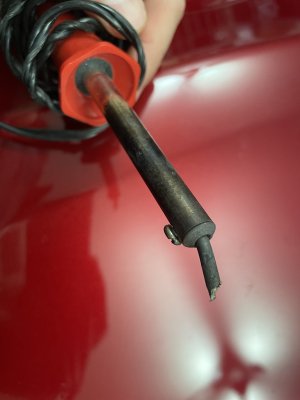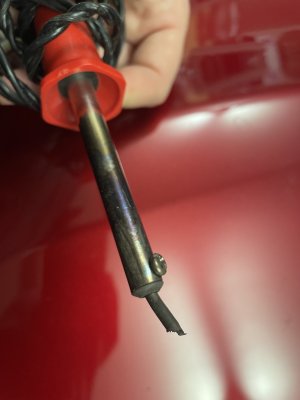morrissey007
Newbie
- Messages
- 12
So, having spent hours today with de-solder braid, continuity testing, reflowing solder joints on every single component etc, I finally nailed down the problem. The PCB is fine, no tracks broken and no solder pads detached from pads, and no dry joints. It was a faulty Volume Pot, one of the three solder lugs was ever so slightly loose on the brown fibre board, as if the rivet wasn't fully tight and the lug could move a miniscule amount and so was not making full contact with the potentiometer track, but it was intermittent, so when I moved the volume or slightly flexed the board it would disconnect/reconnect. I make guitar pedals for fun so luckily I had a replacement pot to hand. I soldered it in and now the amp is fully working, along with the satisfying outcome of the original work (following the replacement of the three TL084s with OPA 4227PAs) it isnow silent!
So, my observations/lessons learnt is;
Firstly; there should be a small but significant addition to the disassembly instructions and, in my opinion, it is a must: 𝗗𝗢 𝗡𝗢𝗧 𝘁𝗶𝗹𝘁 𝘁𝗵𝗲 𝗣𝗿𝗲-𝗮𝗺𝗽 𝗯𝗼𝗮𝗿𝗱 𝘁𝗼 𝗿𝗲𝗺𝗼𝘃𝗲 𝗶𝘁, the slightest bend on the Pots will put a strain on them and could cause damage to them or the PCB, however, the good thing is that this is so simple to avoid and only adds 30 seconds to the work: undo the four screws holding the XLR board and connectors on and move it out of the way (don't even need to undo the earth cable that goes to pillar) this allows the Preamp board to slide in and out without any bend to the pots whatsoever.
Second lesson is; 𝗱𝗼𝗻𝘁 𝗹𝗲𝘁 𝘁𝗵𝗶𝘀 𝗽𝘂𝘁 𝘆𝗼𝘂 𝗼𝗳𝗳! If you have soldering experience then it really is a simple thing to do and reaps great results. It took me 30 minutes to remove the three TL084s and solder some turned pin sockets. I use turned pin as this prevents the chips coming loose when its in transit, which after all; its a guitar amp so its going to get moved, usually!
Finally: 𝗧𝗵𝗶𝘀 𝗶𝘀 𝗮𝗯𝘀𝗼𝗹𝘂𝘁𝗲𝗹𝘆 𝘄𝗼𝗿𝘁𝗵 𝗱𝗼𝗶𝗻𝗴, the reducing is Hiss is phenomenal, its gone from annoying to me having to check if I have the amp switched on!
So, my observations/lessons learnt is;
Firstly; there should be a small but significant addition to the disassembly instructions and, in my opinion, it is a must: 𝗗𝗢 𝗡𝗢𝗧 𝘁𝗶𝗹𝘁 𝘁𝗵𝗲 𝗣𝗿𝗲-𝗮𝗺𝗽 𝗯𝗼𝗮𝗿𝗱 𝘁𝗼 𝗿𝗲𝗺𝗼𝘃𝗲 𝗶𝘁, the slightest bend on the Pots will put a strain on them and could cause damage to them or the PCB, however, the good thing is that this is so simple to avoid and only adds 30 seconds to the work: undo the four screws holding the XLR board and connectors on and move it out of the way (don't even need to undo the earth cable that goes to pillar) this allows the Preamp board to slide in and out without any bend to the pots whatsoever.
Second lesson is; 𝗱𝗼𝗻𝘁 𝗹𝗲𝘁 𝘁𝗵𝗶𝘀 𝗽𝘂𝘁 𝘆𝗼𝘂 𝗼𝗳𝗳! If you have soldering experience then it really is a simple thing to do and reaps great results. It took me 30 minutes to remove the three TL084s and solder some turned pin sockets. I use turned pin as this prevents the chips coming loose when its in transit, which after all; its a guitar amp so its going to get moved, usually!
Finally: 𝗧𝗵𝗶𝘀 𝗶𝘀 𝗮𝗯𝘀𝗼𝗹𝘂𝘁𝗲𝗹𝘆 𝘄𝗼𝗿𝘁𝗵 𝗱𝗼𝗶𝗻𝗴, the reducing is Hiss is phenomenal, its gone from annoying to me having to check if I have the amp switched on!


